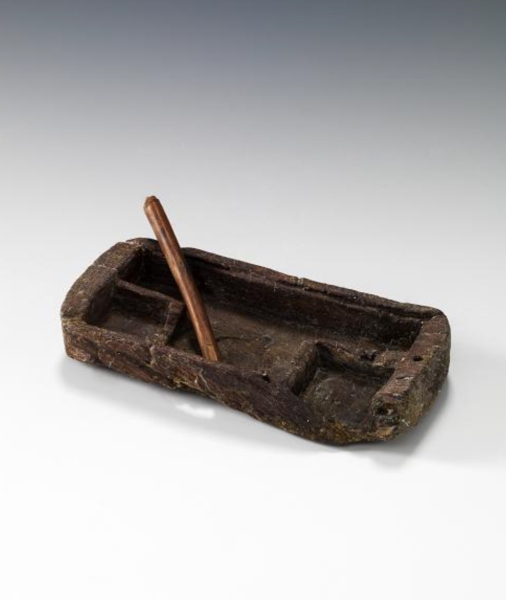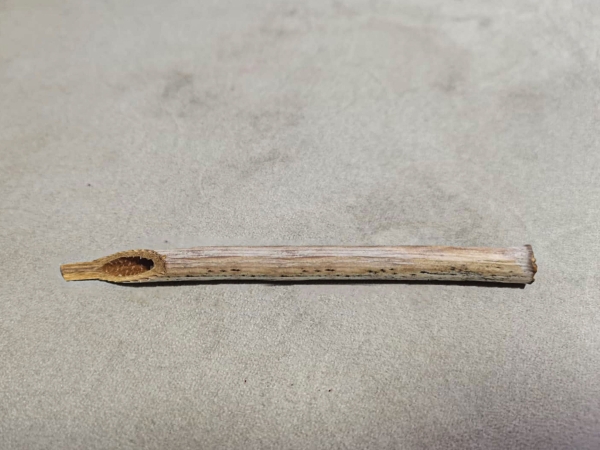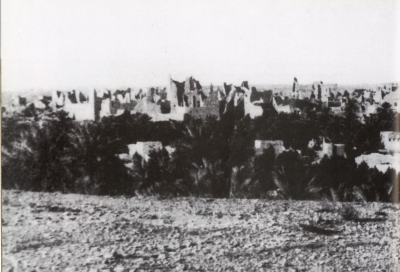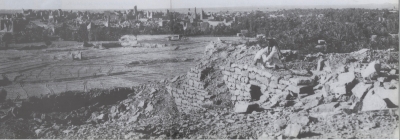


Writing Instruments in the First Saudi State are the writing instruments used before and during the establishment of the First Saudi State. In Najd, the nucleus of the state, writing instruments were similar to those used by humans when they first started writing. Traditional writing instruments found in Najd were made of raw materials available within the local environment. They were simple instruments, including, writing tablets, pens, and inkpots.
Making writing instruments in the First Saudi State
During the establishment of the First Saudi State, the inhabitants of Najd used various types of trees and plants to equip and make writing instruments. In major cities, these instruments were made by carpenters in return for a specific amount. The form and size of these instruments differed depending on the wealth and status of people. In smaller regions, the resident or traveling carpenter would trade the fee with the region's agricultural or animal products, in return for making writing instruments.
Making writing instruments required taking necessary precautions before cutting wood as it should be cut during specific periods of the year, especially at the beginning of the moderate season before winter and during the forty days preceding the cold season. Cutting wood at any time beyond those seasons is harmful, as it causes the wood to crash. Upon cutting, wood is chopped where branches are cut into large pieces. These pieces are left to dry, then moved to the carpentry where they are shaped into joints of various sizes, ultimately used to make writing instruments.
Writing tablets in the First Saudi State
Writing tablets used during the establishment of the First Saudi State consisted of those commonly used among various human civilizations. They were made of wood by teachers, students, their guardians, or carpenters. They were similar to mobile boards used by students to note what they had learned at al-Katatib (School). In Najd, some towns were renowned for tablets sold at the carpenters' markets, where parents would purchase tablets required by their children. Tablets were made of local woods. They were of no specific or known size. Their dimensions ranged between (fifty by twenty cm) and (thirty by twenty cm), more or less, with a thickness ranging between two and three cm.
The tablet would be topped with a hole in its center, either made in the form of a perforated rectangle, ultimately enabling the insertion of a rope for hanging the tablet, which was the most common form, or a hole in the form of a handgrip. Its base was either straight or arc-shaped, as to enable its placement upon the student's thighs without impacting the writing space. Its corners take the form of two pointed sides that can be planted in the ground should the student want to.
Writing pens in the First Saudi State
During the era of the First Saudi State, the people of Najd paid attention to pens. They did not prefer any specific type. Rather, they made use of the types available in the environment of Najd. Pens were usually made from Cladium mariscus (reed), a local species commonly found around wells and waterways. Some towns in Najd, such as al-Aflaj, al-Saih, and Layla, were known for the abundance of water springs. Some trees were known as suitable for making pens. This suitability was due to their abundance, straightness, or ease of use. These include the branches of tamarisk, safflower, calligonum comosum, acacia, and acacia nilotica. The types of pens made would differ depending on their material and the way they are used for writing, whether they were used on wooden tablets or on paper.
Inkpots in the First Saudi State
Inkpots are among the writing instruments used in the First Saudi State. They were known as such due to holding ink therein. They also had several names in Arabic, such as al-Mahaber, al-Dawah, and al-Maqlama. However, the inkpot is the most common name. Local inkpots were usually made of tamarisk wood. They were rectangular and right-angled. The carpenter would carve a small circular hole on one of its sides, thus dedicating a space for placing ink. Its bottom is coated with an insulating material that would prevent ink leak into the wood. It could also feature a small ceramic container or metal plate to serve as a coating layer.
A rectangular basin is carved longitudinally on the rear part of the inkpot. The length of the basin is twelve cm. It has a width of three cm and a depth of around four cm. It is known as the pen holder. The cover of the inkpot is usually made of a flat piece with a similar shape to the pot bottom. The piece might consist of a wooden piece whose thickness is aligned with the inkpot's thickness.
Related quizzes
Related articles

